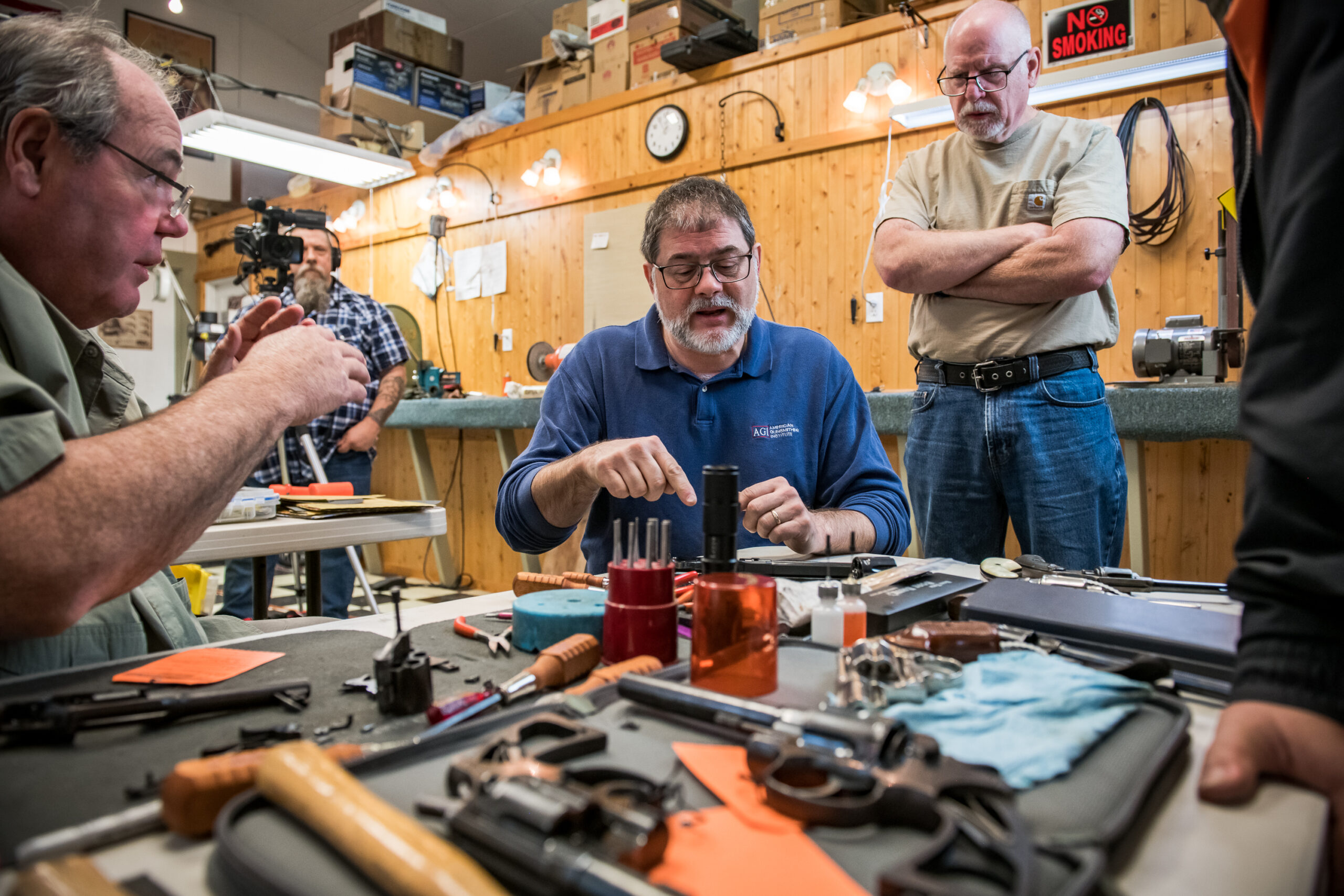
The essence of professional gunsmithing lies not just in working with modern firearms, but in understanding the foundational principles that have shaped firearm design for over a century. At the American Gunsmithing Institute (AGI), we encounter many aspiring gunsmiths who question the relevance of studying classic firearm designs in today’s market. This perspective recently surfaced when someone suggested that training on “older” firearms like the 1911 was unnecessary for modern gunsmiths.
The Enduring Relevance of Classic Designs
What many fail to realize is that today’s most advanced firearms are built upon time-tested mechanical principles that have proven their worth over decades of use. The internal systems that power modern weapons often trace their lineage directly to designs that are over a century old. This isn’t obsolescence – it’s proven excellence that continues to influence contemporary firearm manufacturing.
Consider how modern manufacturers like Kimber, Wilson Combat, and Springfield Armory continue producing 1911-style pistols with remarkably similar internal designs to their predecessors. These aren’t mere replicas but refined iterations of proven mechanical systems that demonstrate the enduring validity of classic design principles.
Core Design Elements in Modern Applications
The evolution of firearm design represents a continuous refinement rather than a complete reinvention. Modern firearms manufacturers have primarily focused on improving materials and manufacturing processes while retaining fundamental mechanical principles. Understanding these foundational elements provides crucial insights for today’s gunsmith:
Core mechanical principles that persist in modern firearms include:
- Operating system fundamentals
- Trigger mechanism designs
- Safety system implementations
- Barrel lock-up methods
Understanding Traditional Mechanisms
The knowledge of classic firearm designs provides invaluable insights into how modern firearms function. This understanding proves essential when diagnosing issues and performing repairs across all platforms. Our experience at AGI has consistently shown that gunsmiths who master classic designs develop superior problem-solving abilities.
Even with contemporary firearms like the SIG P320, we see countless examples of traditional design principles at work. The implementation may look different, but the underlying mechanical concepts remain remarkably consistent. This continuity in design principles illustrates why understanding classic firearms is crucial for modern gunsmiths.
Feed System Evolution
The fundamental principles governing reliable ammunition feeding have remained largely unchanged since the early days of semi-automatic firearms. While materials and manufacturing methods have evolved, the core mechanical concepts continue to define modern firearm design. Our instructors regularly demonstrate how these principles transcend specific models or eras:
Essential feeding system elements include:
- Magazine design geometry
- Spring rate calculations
- Feed lip configurations
- Follower design principles
Operating System Fundamentals
Modern firearms may appear radically different from their predecessors, but their core operating principles often mirror classic designs. This consistency in mechanical function demonstrates the enduring validity of early firearm engineering solutions. Understanding these fundamentals proves invaluable when working on any firearm:
Critical operating system components comprise:
- Firing pin mechanics
- Extractor design principles
- Ejector functionality
- Safety mechanism integration
Professional Development Through Classic Understanding
The path to becoming a certified professional gunsmith requires comprehensive knowledge that spans both classic and modern firearms. This broad understanding enables gunsmiths to provide superior service regardless of the firearm’s age or design. The skills developed through studying classic firearms directly translate to working on modern platforms.
Building Essential Skills
Through years of teaching professional gunsmiths, we’ve identified key competencies that develop from understanding classic firearm designs. These skills prove invaluable whether working on traditional or contemporary firearms:
Fundamental competencies include:
- Mechanical system analysis
- Problem-solving methodology
- Diagnostic techniques
- Safety protocol implementation
Frequently Asked Questions About Classic Gunsmithing
Q: Why is studying classic firearm designs important for modern gunsmiths?
A: Classic designs form the foundation of modern firearm mechanics. Understanding these principles enables better diagnosis and repair across all platforms, both vintage and contemporary.
Q: How do traditional designs influence modern firearms?
A: Modern firearms incorporate many time-tested mechanical principles from classic designs, particularly in their core operating systems, safety mechanisms, and feeding systems.
Q: Can knowledge of classic firearms improve modern gunsmithing skills?
A: Yes, understanding classic mechanical principles develops crucial problem-solving abilities that apply to all firearms, regardless of age or design.
Building a Successful Gunsmithing Career
The comprehensive understanding gained from studying classic firearm designs opens numerous professional opportunities. Whether pursuing full-time gunsmithing, establishing a part-time business, or developing a retirement income stream, this knowledge proves invaluable.
Career Development Pathways
Our experience shows that gunsmiths with strong foundational knowledge enjoy multiple career advantages. This expertise enables them to handle a wider range of work and provide better service to their clients:
Key career benefits include:
- Expanded service capabilities
- Enhanced diagnostic skills
- Improved customer satisfaction
- Increased business opportunities
Conclusion
The journey to mastering modern gunsmithing requires a solid foundation in classic firearm design principles. This knowledge isn’t about living in the past – it’s about understanding the core mechanics that continue to influence today’s firearms. Through AGI’s comprehensive training program, aspiring gunsmiths develop the skills needed to excel in this evolving field.
Ready to transform your approach to gunsmithing? Start your journey with AGI today and discover the satisfaction of truly understanding and solving firearm challenges.
Gene Kelly, Gunsmith and President, American Gunsmithing Institute Gunsmithing Club of America Gunsmithing School https://americangunsmithinginstitute.net
Our retail website with Armorer’s Courses for your guns and more! www.AmericanGunsmith.com
The place for like-minded people and all things Gunsmithing www.GunsmithingClubofAmerica.com




